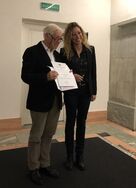Paul Scherrer Institut
-
Swiss Aerosol Award 2019: emissions with a special focus on biomass burning
 Press relase: Download:
Press relase: Download:  SwissAerosolAward-2019_Giulia-Stefenelli.pdf58.7 kB
SwissAerosolAward-2019_Giulia-Stefenelli.pdf58.7 kBDr. Giulia Stefenelli, PhD of ETH Zürich and researcher at the Paul Scherrer Institute in Würenlingen, has received yesterday in Berne the Swiss Aerosol Award 2019 for her excellent work about biomass burning*.
Giulia Stefenelli and coauthors present herein a new method to model the secondary organic aerosol (SOA) formation from complex emissions with a special focus on biomass burning. Biomass burning emissions from residential combustion are a major source of gaseous and particulate air pollution on urban, regional and global scales.
Here, using smog chamber measurements, the authors estimate the contribution of different precursor classes to the SOA formed during emission aging. They demonstrate that SOA yields of these precursor classes in complex emissions can largely be represented by yields determined using single precursors. For SOA yield calculations, they developed a new box model solved using advanced data science techniques.
This modelling framework may be generalizable for other complex emissions sources, enabling the determination of the contributions of different chemical classes at a level of complexity suitable for implementation in regional air quality models. The authors reveal the most important precursors in biomass burning emissions, and the modelling framework developed can be used to follow the evolution of their oxidation products in the particle phase, allowing a direct comparison with molecular composition measurements using recently developed chemical ionization mass spectrometers.
SOA production by most of these precursors has received little study so far; therefore, data analysis methods developed here suggest directions for future laboratory studies and a clear path for constraining SOA effects and supporting source specific mitigation policies.
*Secondary organic aerosol formation from smoldering and flaming combustion of biomass: a box model parametrization based on volatility basis set.
Giulia Stefenelli, Jianhui Jiang, Amelie Bertrand, Emily A. Bruns, Simone M. Pieber, Urs Baltensperger et al; Atmos. Chem. Phys., 19, 11461–11484, 2019; https://doi.org/10.5194/acp-19-11461-2019
-
Swiss Aerosol Award 2019: Luftschadstoffe bei der Verbrennung von Biomasse
 Medienmitteilung: Download:
Medienmitteilung: Download:  SwissAerosolAward-2019_Giulia-Stefenelli.pdf58.7 kB
SwissAerosolAward-2019_Giulia-Stefenelli.pdf58.7 kBFrau Dr. Giulia Stefenelli, PhD der ETH Zürich und Mitarbeiterin des Paul Scherrer Instituts in Würenlingen hat den Swiss Aerosol Award 2019 gestern in Bern erhalten für ihre Arbeit über Luftschadstoffe bei der Verbrennung von Biomasse, einem weltweit dringenden Gesundheits- und Klimaproblem*.
Die Verbrennung von Biomasse wie Holz und anderen organischen Stoffen pflanzlichen oder tierischen Ursprungs zum Kochen und Heizen ist eine der wichtigsten Ursachen der Luftverschmutzung weltweit.
Frau Stefenelli hat zusammen mit ihren Mitautoren eine neue Methode entwickelt, die Bildung von sogenanntem sekundärem organischem Aerosol (SOA) in diesen Verbrennungsprozessen zu beschreiben. Je nach der verbrannten Substanz entwickeln sich im Rauch mit der Zeit verschiedene solche gesundheitsschädigende SOA Bestandteile.
Basierend auf Messungen in atmosphärischen Simulationskammern konnten die Autoren die Anteile der verschiedenen Vorläufersubstanzen an dieser SOA-Bildung berechnen. In Zukunft kann es genügen, die Vorläufersubstanzen zu messen, um die SOA-Bildung in der Atmosphäre abzuschätzen.
Weiter können Marker In der Aussenluft verwendet werden, um den Beitrag der Biomassenverbrennung zur gesamten Feinstaubmasse abzuschätzen. Dies sind schlussendlich wichtige Hilfsmittel und Informationen, um die relevanten Emissionen an der Quelle zu kontrollieren und um die Notwendigkeit der Emissionsreduktionen aufzuzeigen.
*Secondary organic aerosol formation from smoldering and flaming combustion of biomass: a box model parametrization based on volatility basis set.
Giulia Stefenelli, Jianhui Jiang, Amelie Bertrand, Emily A. Bruns, Simone M. Pieber, Urs Baltensperger et al; Atmos. Chem. Phys., 19, 11461–11484, 2019; https://doi.org/10.5194/acp-19-11461-2019


